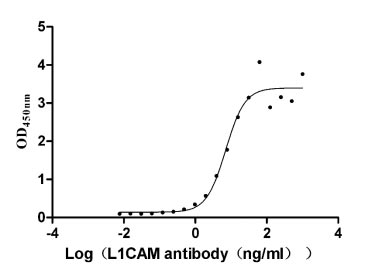Recombinant Rat Tristetraprolin (Zfp36)
-
中文名称:大鼠Zfp36重组蛋白
-
货号:CSB-YP026448RA
-
规格:
-
来源:Yeast
-
其他:
-
中文名称:大鼠Zfp36重组蛋白
-
货号:CSB-EP026448RA
-
规格:
-
来源:E.coli
-
其他:
-
中文名称:大鼠Zfp36重组蛋白
-
货号:CSB-EP026448RA-B
-
规格:
-
来源:E.coli
-
共轭:Avi-tag Biotinylated
E. coli biotin ligase (BirA) is highly specific in covalently attaching biotin to the 15 amino acid AviTag peptide. This recombinant protein was biotinylated in vivo by AviTag-BirA technology, which method is BriA catalyzes amide linkage between the biotin and the specific lysine of the AviTag.
-
其他:
-
中文名称:大鼠Zfp36重组蛋白
-
货号:CSB-BP026448RA
-
规格:
-
来源:Baculovirus
-
其他:
-
中文名称:大鼠Zfp36重组蛋白
-
货号:CSB-MP026448RA
-
规格:
-
来源:Mammalian cell
-
其他:
产品详情
-
纯度:>85% (SDS-PAGE)
-
基因名:Zfp36
-
Uniprot No.:
-
别名:Zfp36; Tis11; Ttp; mRNA decay activator protein ZFP36; TPA-induced sequence 11; Tristetraprolin; Zinc finger protein 36; Zfp-36
-
种属:Rattus norvegicus (Rat)
-
蛋白长度:Full length protein
-
表达区域:1-320
-
氨基酸序列MDLSAIYESLMSMSHDLSPDHGGTESSGGLWNINSSDSIPSGVTSRLTGRSTSLVEGRSC SWVPPPPGFAPLAPRPGPELSPSPTSPTATPTTSSRYKTELCRTYSESGRCRYGAKCQFA HGPGELRQANRHPKYKTELCHKFYLQGRCPYGSRCHFIHNPTEDLALPGQPHVLRQSISF SGLPSGRRTSPPPPGFSGPSLSSCSFSPSSSPPPPGDLPLSPSAFSAAPGTPVSRRDPTP ACCPSCRRSTTPSTIWGPLGGLARSPSAHSLGSDPDDYASSGSSLGGSDSPVFEAGVFGP PQPPAPPRRLPIFNRISVSE
-
蛋白标签:Tag type will be determined during the manufacturing process.
The tag type will be determined during production process. If you have specified tag type, please tell us and we will develop the specified tag preferentially. -
产品提供形式:Lyophilized powder
Note: We will preferentially ship the format that we have in stock, however, if you have any special requirement for the format, please remark your requirement when placing the order, we will prepare according to your demand. -
复溶:We recommend that this vial be briefly centrifuged prior to opening to bring the contents to the bottom. Please reconstitute protein in deionized sterile water to a concentration of 0.1-1.0 mg/mL.We recommend to add 5-50% of glycerol (final concentration) and aliquot for long-term storage at -20℃/-80℃. Our default final concentration of glycerol is 50%. Customers could use it as reference.
-
储存条件:Store at -20°C/-80°C upon receipt, aliquoting is necessary for mutiple use. Avoid repeated freeze-thaw cycles.
-
保质期:The shelf life is related to many factors, storage state, buffer ingredients, storage temperature and the stability of the protein itself.
Generally, the shelf life of liquid form is 6 months at -20°C/-80°C. The shelf life of lyophilized form is 12 months at -20°C/-80°C. -
货期:Delivery time may differ from different purchasing way or location, please kindly consult your local distributors for specific delivery time.Note: All of our proteins are default shipped with normal blue ice packs, if you request to ship with dry ice, please communicate with us in advance and extra fees will be charged.
-
注意事项:Repeated freezing and thawing is not recommended. Store working aliquots at 4°C for up to one week.
-
Datasheet :Please contact us to get it.
靶点详情
-
功能:Zinc-finger RNA-binding protein that destabilizes numerous cytoplasmic AU-rich element (ARE)-containing mRNA transcripts by promoting their poly(A) tail removal or deadenylation, and hence provide a mechanism for attenuating protein synthesis. Acts as an 3'-untranslated region (UTR) ARE mRNA-binding adapter protein to communicate signaling events to the mRNA decay machinery. Recruits deadenylase CNOT7 (and probably the CCR4-NOT complex) via association with CNOT1, and hence promotes ARE-mediated mRNA deadenylation. Functions also by recruiting components of the cytoplasmic RNA decay machinery to the bound ARE-containing mRNAs. Self regulates by destabilizing its own mRNA. Binds to 3'-UTR ARE of numerous mRNAs. Binds also to ARE of its own mRNA. Plays a role in anti-inflammatory responses; suppresses tumor necrosis factor (TNF)-alpha production by stimulating ARE-mediated TNF-alpha mRNA decay and several other inflammatory ARE-containing mRNAs in interferon (IFN)- and/or lipopolysaccharide (LPS)-induced macrophages. Plays also a role in the regulation of dendritic cell maturation at the post-transcriptional level, and hence operates as part of a negative feedback loop to limit the inflammatory response. Promotes ARE-mediated mRNA decay of hypoxia-inducible factor HIF1A mRNA during the response of endothelial cells to hypoxia. Positively regulates early adipogenesis of preadipocytes by promoting ARE-mediated mRNA decay of immediate early genes (IEGs). Negatively regulates hematopoietic/erythroid cell differentiation by promoting ARE-mediated mRNA decay of the transcription factor STAT5B mRNA. Plays a role in maintaining skeletal muscle satellite cell quiescence by promoting ARE-mediated mRNA decay of the myogenic determination factor MYOD1 mRNA. Associates also with and regulates the expression of non-ARE-containing target mRNAs at the post-transcriptional level, such as MHC class I mRNAs. Participates in association with argonaute RISC catalytic components in the ARE-mediated mRNA decay mechanism; assists microRNA (miRNA) targeting ARE-containing mRNAs. May also play a role in the regulation of cytoplasmic mRNA decapping; enhances decapping of ARE-containing RNAs, in vitro. Involved in the delivery of target ARE-mRNAs to processing bodies (PBs). In addition to its cytosolic mRNA-decay function, affects nuclear pre-mRNA processing. Negatively regulates nuclear poly(A)-binding protein PABPN1-stimulated polyadenylation activity on ARE-containing pre-mRNA during LPS-stimulated macrophages. Also involved in the regulation of stress granule (SG) and P-body (PB) formation and fusion. Plays a role in the regulation of keratinocyte proliferation, differentiation and apoptosis. Plays a role as a tumor suppressor by inhibiting cell proliferation in breast cancer cells.
-
基因功能参考文献:
- TGF-beta as a novel mRNA stability regulator in intestinal epithelium through its ability to promote TTP expression and subsequent P-body formation. PMID: 24190969
- Identification of nuclear import and export signals within the structure of the zinc finger protein TIS11 PMID: 12054509
- recruitment of TIS11 to heat shock-induced stress granules is governed by the tandem zinc finger domains of this protein PMID: 15652343
-
亚细胞定位:Nucleus. Cytoplasm. Cytoplasmic granule. Cytoplasm, P-body.
-
数据库链接:
KEGG: rno:79426
STRING: 10116.ENSRNOP00000026661
UniGene: Rn.82737
Most popular with customers
-
Recombinant Human Neural cell adhesion molecule L1 (L1CAM), partial (Active)
Express system: Mammalian cell
Species: Homo sapiens (Human)
-
Recombinant Human C-X-C chemokine receptor type 4 (CXCR4)-VLPs (Active)
Express system: Mammalian cell
Species: Homo sapiens (Human)
-
Recombinant Human Claudin-4 (CLDN4)-VLPs (Active)
Express system: Mammalian cell
Species: Homo sapiens (Human)
-
Recombinant Rat Gastric inhibitory polypeptide receptor (Gipr), partial (Active)
Express system: Mammalian cell
Species: Rattus norvegicus (Rat)
-
Recombinant Human Tumor necrosis factor ligand superfamily member 15(TNFSF15) (Active)
Express system: Mammalian cell
Species: Homo sapiens (Human)



-AC1.jpg)


-AC1.jpg)










